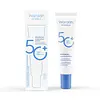What's inside
What's inside
 Key Ingredients
Key Ingredients

 Benefits
Benefits

 Concerns
Concerns

No concerns
 Ingredients Side-by-side
Ingredients Side-by-side

Water
Skin ConditioningZinc Oxide
Cosmetic ColorantC12-15 Alkyl Benzoate
AntimicrobialPropanediol
SolventMaleated Soybean Oil Glyceryl/Octyldodecanol Esters
Trisiloxane
Skin ConditioningBiosaccharide Gum-1
HumectantDibutyl Adipate
EmollientHydroxyethyl Acrylate/Sodium Acryloyldimethyl Taurate Copolymer
Emulsion StabilisingBisabolol
MaskingGlycerin
HumectantAllantoin
Skin ConditioningAvena Sativa Kernel Flour
AbrasiveCaprylhydroxamic Acid
Phenoxyethanol
PreservativeArtemisia Capillaris Flower Extract
Skin ConditioningHouttuynia Cordata Extract
Skin ConditioningHaberlea Rhodopensis Leaf Extract
Skin ConditioningCamellia Sinensis Leaf Extract
AntimicrobialPolymethylsilsesquioxane
1,2-Hexanediol
Skin ConditioningArachidyl Alcohol
EmollientButylene Glycol
HumectantTriethoxycaprylylsilane
Polyacrylate Crosspolymer-6
Emulsion StabilisingPolyhydroxystearic Acid
EmulsifyingBehenyl Alcohol
EmollientChlorphenesin
AntimicrobialArachidyl Glucoside
EmulsifyingWater, Zinc Oxide, C12-15 Alkyl Benzoate, Propanediol, Maleated Soybean Oil Glyceryl/Octyldodecanol Esters, Trisiloxane, Biosaccharide Gum-1, Dibutyl Adipate, Hydroxyethyl Acrylate/Sodium Acryloyldimethyl Taurate Copolymer, Bisabolol, Glycerin, Allantoin, Avena Sativa Kernel Flour, Caprylhydroxamic Acid, Phenoxyethanol, Artemisia Capillaris Flower Extract, Houttuynia Cordata Extract, Haberlea Rhodopensis Leaf Extract, Camellia Sinensis Leaf Extract, Polymethylsilsesquioxane, 1,2-Hexanediol, Arachidyl Alcohol, Butylene Glycol, Triethoxycaprylylsilane, Polyacrylate Crosspolymer-6, Polyhydroxystearic Acid, Behenyl Alcohol, Chlorphenesin, Arachidyl Glucoside
Titanium Dioxide
Cosmetic ColorantDimethicone
EmollientZinc Oxide
Cosmetic ColorantLactobacillus
Skin ConditioningPassiflora Incarnata Extract
AstringentButylene Glycol
HumectantDimethicone/PEG-10/15 Crosspolymer
Neopentyl Glycol Diheptanoate
EmollientSilica
AbrasiveVinyldimethicone
Polyglyceryl-3 Polydimethylsiloxyethyl Dimethicone
Skin ConditioningSodium Chloride
MaskingPEG-10 Dimethicone
Skin ConditioningAluminum Hydroxide
EmollientStearic Acid
CleansingTocopheryl Acetate
Antioxidant1,2-Hexanediol
Skin ConditioningSodium Hyaluronate Crosspolymer
HumectantSodium Hyaluronate
HumectantTitanium Dioxide, Dimethicone, Zinc Oxide, Lactobacillus, Passiflora Incarnata Extract, Butylene Glycol, Dimethicone/PEG-10/15 Crosspolymer, Neopentyl Glycol Diheptanoate, Silica, Vinyldimethicone, Polyglyceryl-3 Polydimethylsiloxyethyl Dimethicone, Sodium Chloride, PEG-10 Dimethicone, Aluminum Hydroxide, Stearic Acid, Tocopheryl Acetate, 1,2-Hexanediol, Sodium Hyaluronate Crosspolymer, Sodium Hyaluronate
 Reviews
Reviews

Ingredients Explained
These ingredients are found in both products.
Ingredients higher up in an ingredient list are typically present in a larger amount.
1,2-Hexanediol is a synthetic liquid and another multi-functional powerhouse.
It is a:
- Humectant, drawing moisture into the skin
- Emollient, helping to soften skin
- Solvent, dispersing and stabilizing formulas
- Preservative booster, enhancing the antimicrobial activity of other preservatives
Butylene Glycol (or BG) is used within cosmetic products for a few different reasons:
Overall, Butylene Glycol is a safe and well-rounded ingredient that works well with other ingredients.
Though this ingredient works well with most skin types, some people with sensitive skin may experience a reaction such as allergic rashes, closed comedones, or itchiness.
Learn more about Butylene GlycolZinc Oxide is a mineral broad-spectrum UV filter; it is the broadest UVA and UVB reflector approved by the FDA. It also has skin protectant and skin soothing properties.
Zinc oxide is one of the most effective broad-spectrum UV filters. It protects against UVB, UVAII, and UVAI. In comparison to its counterpart titanium dioxide, zinc oxide provides uniform and extended UVA protection.
Another great benefit? This ingredient is highly photostable so it won't degrade easily under sunlight.
A common myth is that mineral UV filters are widely believed to primarily reflect UV light.
However, modern research shows titanium dioxide absorbs UV radiation like chemical filters (~95% absorption & 5% reflection).
Zinc oxide has great skin soothing properties so you'll likely find this in sunscreens formulated for sensitive skin or babies/children. It is unlikely to cause "eye sting" like other sunscreen ingredients.
Regulatory agencies consider zinc oxide to be non-toxic and safe. It has also been shown to not penetrate the skin.
Unfortunately, this ingredient does leave a visible white cast. This is why mineral sunscreens are often less cosmetically elegant than chemical or hybrid ones.
In cosmetics, zinc oxide can be found in both non-nano and nano-sized forms. The nano version is used to reduce white cast and improve the texture of sunscreen formulas.
There are ongoing concerns surrounding nano-zinc oxide's impact on marine ecosystems and whether it can be absorbed into skin.
Regarding marine ecosystems and coral reefs, there is no conclusive evidence that any form of zinc oxide (or any other sunscreen ingredients) will cause harm. The science is still developing but many consumers are keeping a close eye on this issue.
Please note, many destinations have reef-safety sunscreen rules. For instance, the U.S. Virgin Islands advises all visitors to use non-nano mineral sunscreens.
There has also been some stir about whether micronized or nano zinc oxide has potential photoxicity and absorption through the skin/lungs.
An in-vitro (done in a test tube or petri dish) study demonstrated micronized zinc oxide to have potential phototoxicity. There's no need to fret; the EU Commission's Scientific Committee on Consumer Safety has stated, "The relevance of these findings needs to be clarified by appropriate investigations in vivo." Or in other words, further studies done on living organisms are needed to prove this.
Current research shows zinc oxide nanoparticles do not penetrate intact or sunburned skin. They either remain on the surface or in the outermost layer of dead skin (stratum corneum).
Zinc oxide is one of only two classified mineral UV filters with titanium dioxide being the other one.
Fun fact: Zinc has been used throughout history as an ingredient in paint and medicine. An Indian text from 500BC is believed to list zinc oxide as a salve for open wound. The Ancient Greek physician Dioscorides has also mentioned the use of zinc as an ointment in 1AD.
Learn more about Zinc Oxide